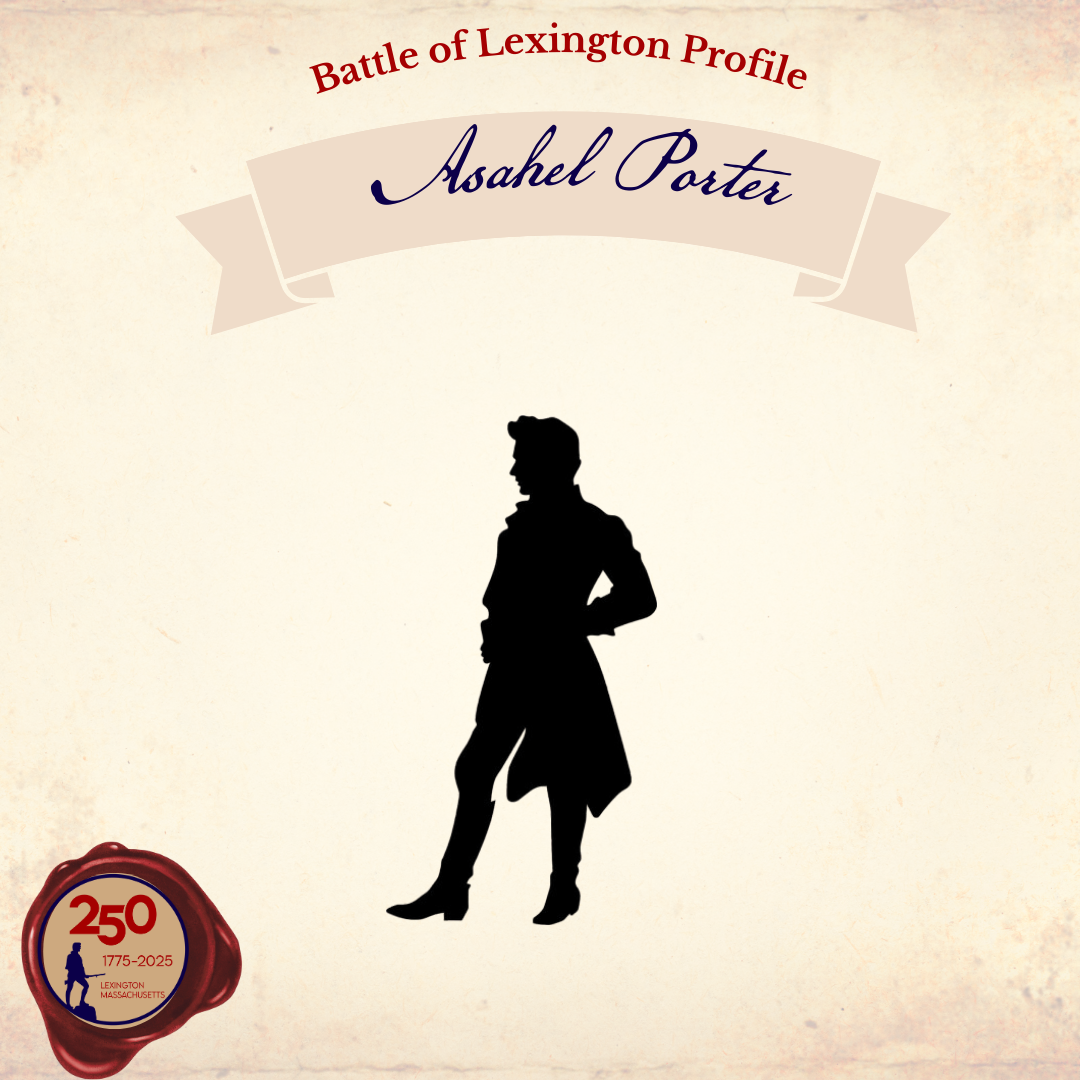
Asahel Porter
Born 1752, killed April 19, 1775
In honor of the upcoming Parker’s Prelude celebrations, the Lex250 Commission would like to shed light on those who were present on April 19, 1775, at the Battle of Lexington. Asahel Porter was a civilian prisoner of war and died on April 19, 1775
Asahel Porter was about 23 years old when he was shot by British troops.
Asahel Porter was living in Woburn and working as a farmer, and on the morning of April 19, 1775, Porter and another Woburn farmer, Josiah Richardson, set out for Boston on horseback to sell their farm goods.
Along the way, Porter and Richardson ran into the British army column, moving west along the same road toward Concord.
The regulars took Porter and Richardson’s horses and farm goods, made sure they were unarmed, and ordered them to walk in the middle of the ranks. As the troops got closer to Lexington, the mounted officers spotted another young man on horseback, Simon Winship.
The British were wary that the men would alert the rest of Lexington that they were approaching, so the men were forced to stay with the soldiers. Once shots rang out on the Common, the British officers decided to release Porter, Richardson, and Winship.
Upon his release, Richardson was ordered not to run; apparently being informed that if he did run he would be shot.
In Silas Dean’s Brief History of the Town of Stoneham (1870), Dean wrote:
“Richardson did as he was told to do; and though he was told to run, he walked away, and was not injured. The reason why he was ordered to run was this: that the guard might think him a deserter, and thereby, in the discharge of their duty, shoot him.
Mr. Porter not being apprised of their artifice in telling him to run, got permission, in the same way of Richardson. Having liberty to go, he sat out upon the run. On getting over a wall a short distance off, he was fired upon and received his death wound.”
In 1824, Amos Lock of Lexington gave an affidavit and recalled seeing Porter’s body. Amos and his brother Ebenezer had mustered with the militia but headed home. He said:
We had not proceeded far, before we heard a firing; upon which we immediately returned, coming up towards the easterly side of the common, where, under the cover of a wall, about twenty rods distant from the common, where the British then were, we found Asahel Porter, of Woburn, shot through the body;
upon which Ebenezer Lock took aim, and discharged his gun at the Britons, who were then but about twenty rods from us. We then fell back a short distance, and the enemy, soon after, commenced their march for Concord.
Porter’s body was dug up and moved to Woburn just days after the battle occurred. His body has been buried in Woburn since 1775. In 1975, the Baldwin Historical Society erected a stone monument for Porter at the First Burial Ground in Woburn, which reads:
Although a Man of Peace
he was caught in a conflict
not of his choosing.
As a result he became
one of the first to die
for his New Country.”
His name is also inscribed on the Revolutionary War Monument in Lexington.

References:
- Bell, J. L. (2010, April 20). The aftermath of Asahel Porter. Boston 1775. https://boston1775.blogspot.com/2010/04/aftermath-of-asahel-porter.html
- Dean, S. (1870). History. In A brief history of the town of Stoneham, Mass. : from its first settlement to the year 1843 : with an account of the murder of Jacob Gould, on the evening of Nov. 25, 1819 (Vol. 1, pp. 8–9). essay, Sentinel Press. https://archive.org/details/briefhistoryofto00deanrich/page/8/mode/2up?q=richardson
- Hudson, C. (1995). History of the town of Lexington, Middlesex County, Massachusetts, from its first settlement to 1868. Library of Congress.
- https://tile.loc.gov/storage-services/public/gdcmassbookdig/historyoftownofl00hudsa/historyoftownofl00hudsa.pdf
